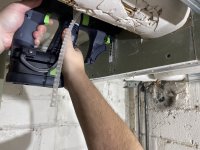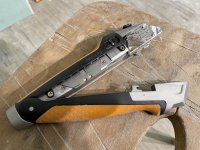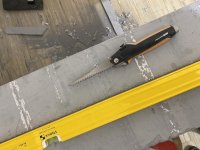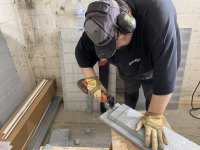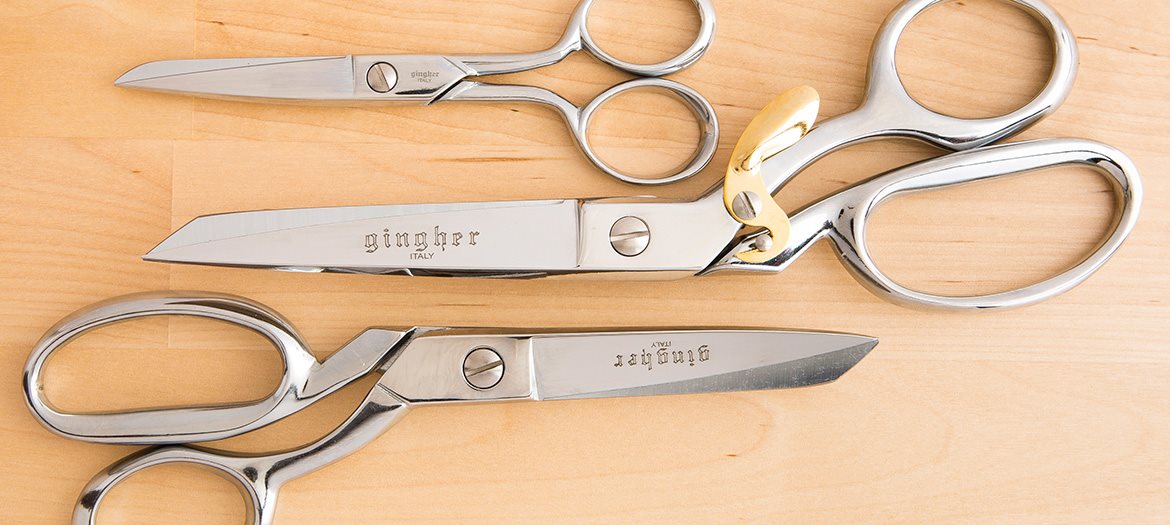six-point socket II
Member
- Joined
- Jun 26, 2016
- Messages
- 2,232
So for years now I'm a pretty happy Fiskars customer. It all started during my youth when I spent a bit of time "outdoors", you could say in the woods with some older friends. Someone gave me a Fiskars splitting axe, they had just come out with the composite handle. That thing rocked. (Albeit there were unproven? claims that on the first batches the composite wasn't as reliable/ robust as it should have been. In fact, I have seen one of those old ones with a broken shaft - but I never got to know how that really happened.
Years later, with our backyard, I bought some of their gardening tools.
A X5 Hatchet, which is pretty much like this but way shorter:https://www.fiskars.com/en-us/garde...-mauls-and-machetes/x7-hatchet-14-378501-1005
The Leaf Rake, like this but with a wooden handle:https://www.fiskars.com/en-us/gardening-and-yard-care/products/rakes/leaf-rake-396560-1001
The Ergo D-Handle Shovel:https://www.fiskars.com/en-us/garde...ols/ergo-d-handle-steel-shovel-49-331410-1001
The Snow Shovel:https://www.fiskars.com/en-us/garde...gging-tools/snow-pusher-shovel-60-343000-1001
The Weed Puller:https://www.fiskars.com/en-us/garde...eders/stand-up-weed-puller-4-claw-339950-1001
The Super Pruner:https://www.fiskars.com/en-us/garde...s/powergear-super-prunerlopper-15-379721-1005
The Pruning Stik:https://www.fiskars.com/en-us/garde...runers/pruning-stik-tree-pruner-5-392341-1005
All of these tools make gardening/ owning a house and life in general so much easier. They are anything between great to fantastic. I have one complaint with the weed puller though, the collateral damage it creates makes this one sit idle in the shed, most of the time.
In November I was watching a few Youtube videos in which the creators/influencer went to big box stores to shop & show the Black Friday offers to kill some time. My wife caught me, and I told her that I'd like to get small, tool related item for Christmas. That's where the FiskarsPro Drywaller's knife came in, it seemed to make a neat stocking stuffer since I would do a bit of drywalling in the new year. So we got that.
Basically it's a foldable jab-saw with built-in utility knife, or a utility knife with built-in foldable jab-saw.
This is what it looks like.
[attachimg=1]
Utility knife.
[attachimg=2]
Jab-saw. Nice, sharp but rounded (I guess for longevity and ease of starting the cut) teeth, and a pointy tip for penetration.
[attachimg=3]
(In case someone is wondering what the folding ruler says: A tradesman doesn't take a break, he merely gives his tools time to recover.)
Internal view on mechanism and blade storage. The blade sits on a carrier and is held by magnets. When pushing the blade out, the whole carrier moves downward and the blade is exposed. The blade it comes with is Made in U.S.A., but the knife itself is Made in China.
[attachimg=4]
So far so good. Knife has great fit and finish, offers an ergonomic and secure grip - feels good in hand. 2k handle. Black is hard, orange is soft(er). No complaints here.
Everyone who has worked with drywall knows there is a reason why when installing it you cut it once or twice and then snap it. It's the least dusty and overall easiest way of working with it. Now when it is already installed or when making cutouts that doesn't always work, obviously.
[attachimg=5]
[attachimg=6]
Note: I'm using the dust extractor here because I wanted to see the line where I needed to make my cut.
[attachimg=7]
[attachimg=8]
[attachimg=9]
And last, the packaging.
[attachimg=10]
[attachimg=11]
At this point I have some complaints, and please keep in mind this was only a minor tear out - replace drain pipe - patch up project.
After using the folding saw overhead, obviously the whole knife was covered in drywall dust. Without blowing on the pivot area and locking mechanism, it went from smooth action to rather notchy. After blowing it out, it was OK. But I did not drywall a room or a house, I was taking out a small piece. Duh.
When I patched it back up, I made a couple of cuts, retracted the blade and installed the first parts of my patch. Then I needed the blade again and ugh, I had to push hard to overcome a certain threshold, dust came out and then it worked again rather smooth.
Obviously this process kinda repeated itself multiple times when changing from blade to saw or vice versa.
Now if they had marketed this as a hobby or DIY product for someone who mainly needs a nice utility knife and maybe once or twice in his lifetime makes a small cutout with the saw I wouldn't have said anything.
But given my experience with Fiskars and the fact they label this professional, I would have expected a more thoughtful design/ protection against ingress of dust or whatever.
I honestly can't begin to imagine how this would hold up with someone who does drywall for a living. I think someone like that would clean it once, maybe twice - and then leave it in the desk at his shop or make it a paper weight. And I also can't begin to imagine what happens if this gets wet because said Pro has it in his cargo pocket when picking up materials or whatever. Or it's left outside in a designated work area and it gets simply a little humid ...
I guess then you would spent a lot of time cleaning this.
I think it's a shame because basically it is a really comfortable utility knife with a useful, sharp and well working jab-saw. But for the life of me, I can't see how this would perform well in a professional/trade environment.
I do have quite some drywalling to do in the not so distant future beside that "quickie" shown above, and I will use it until it either gives up under real world conditions without half-hourly maintenance - or proves me wrong - I'll update this thread then.
Kind regards,
Oliver
Years later, with our backyard, I bought some of their gardening tools.
A X5 Hatchet, which is pretty much like this but way shorter:https://www.fiskars.com/en-us/garde...-mauls-and-machetes/x7-hatchet-14-378501-1005
The Leaf Rake, like this but with a wooden handle:https://www.fiskars.com/en-us/gardening-and-yard-care/products/rakes/leaf-rake-396560-1001
The Ergo D-Handle Shovel:https://www.fiskars.com/en-us/garde...ols/ergo-d-handle-steel-shovel-49-331410-1001
The Snow Shovel:https://www.fiskars.com/en-us/garde...gging-tools/snow-pusher-shovel-60-343000-1001
The Weed Puller:https://www.fiskars.com/en-us/garde...eders/stand-up-weed-puller-4-claw-339950-1001
The Super Pruner:https://www.fiskars.com/en-us/garde...s/powergear-super-prunerlopper-15-379721-1005
The Pruning Stik:https://www.fiskars.com/en-us/garde...runers/pruning-stik-tree-pruner-5-392341-1005
All of these tools make gardening/ owning a house and life in general so much easier. They are anything between great to fantastic. I have one complaint with the weed puller though, the collateral damage it creates makes this one sit idle in the shed, most of the time.
In November I was watching a few Youtube videos in which the creators/influencer went to big box stores to shop & show the Black Friday offers to kill some time. My wife caught me, and I told her that I'd like to get small, tool related item for Christmas. That's where the FiskarsPro Drywaller's knife came in, it seemed to make a neat stocking stuffer since I would do a bit of drywalling in the new year. So we got that.
Basically it's a foldable jab-saw with built-in utility knife, or a utility knife with built-in foldable jab-saw.
This is what it looks like.
[attachimg=1]
Utility knife.
[attachimg=2]
Jab-saw. Nice, sharp but rounded (I guess for longevity and ease of starting the cut) teeth, and a pointy tip for penetration.
[attachimg=3]
(In case someone is wondering what the folding ruler says: A tradesman doesn't take a break, he merely gives his tools time to recover.)
Internal view on mechanism and blade storage. The blade sits on a carrier and is held by magnets. When pushing the blade out, the whole carrier moves downward and the blade is exposed. The blade it comes with is Made in U.S.A., but the knife itself is Made in China.
[attachimg=4]
So far so good. Knife has great fit and finish, offers an ergonomic and secure grip - feels good in hand. 2k handle. Black is hard, orange is soft(er). No complaints here.
Everyone who has worked with drywall knows there is a reason why when installing it you cut it once or twice and then snap it. It's the least dusty and overall easiest way of working with it. Now when it is already installed or when making cutouts that doesn't always work, obviously.
[attachimg=5]
[attachimg=6]
Note: I'm using the dust extractor here because I wanted to see the line where I needed to make my cut.
[attachimg=7]
[attachimg=8]
[attachimg=9]
And last, the packaging.
[attachimg=10]
[attachimg=11]
At this point I have some complaints, and please keep in mind this was only a minor tear out - replace drain pipe - patch up project.
After using the folding saw overhead, obviously the whole knife was covered in drywall dust. Without blowing on the pivot area and locking mechanism, it went from smooth action to rather notchy. After blowing it out, it was OK. But I did not drywall a room or a house, I was taking out a small piece. Duh.
When I patched it back up, I made a couple of cuts, retracted the blade and installed the first parts of my patch. Then I needed the blade again and ugh, I had to push hard to overcome a certain threshold, dust came out and then it worked again rather smooth.
Obviously this process kinda repeated itself multiple times when changing from blade to saw or vice versa.
Now if they had marketed this as a hobby or DIY product for someone who mainly needs a nice utility knife and maybe once or twice in his lifetime makes a small cutout with the saw I wouldn't have said anything.
But given my experience with Fiskars and the fact they label this professional, I would have expected a more thoughtful design/ protection against ingress of dust or whatever.
I honestly can't begin to imagine how this would hold up with someone who does drywall for a living. I think someone like that would clean it once, maybe twice - and then leave it in the desk at his shop or make it a paper weight. And I also can't begin to imagine what happens if this gets wet because said Pro has it in his cargo pocket when picking up materials or whatever. Or it's left outside in a designated work area and it gets simply a little humid ...
I guess then you would spent a lot of time cleaning this.
I think it's a shame because basically it is a really comfortable utility knife with a useful, sharp and well working jab-saw. But for the life of me, I can't see how this would perform well in a professional/trade environment.
I do have quite some drywalling to do in the not so distant future beside that "quickie" shown above, and I will use it until it either gives up under real world conditions without half-hourly maintenance - or proves me wrong - I'll update this thread then.
Kind regards,
Oliver
Attachments
-
 IMG_5765.jpeg236.2 KB · Views: 1,427
IMG_5765.jpeg236.2 KB · Views: 1,427 -
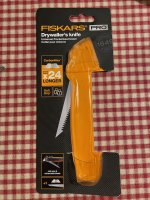 IMG_5747.jpeg450.6 KB · Views: 1,281
IMG_5747.jpeg450.6 KB · Views: 1,281 -
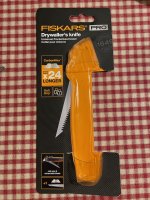 IMG_5747.jpeg450.6 KB · Views: 1,298
IMG_5747.jpeg450.6 KB · Views: 1,298 -
 IMG_6014.jpeg325.5 KB · Views: 1,295
IMG_6014.jpeg325.5 KB · Views: 1,295 -
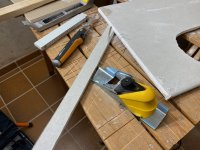 IMG_5994.jpeg282 KB · Views: 1,290
IMG_5994.jpeg282 KB · Views: 1,290 -
 IMG_5985.jpeg219.3 KB · Views: 1,299
IMG_5985.jpeg219.3 KB · Views: 1,299 -
 IMG_5978.jpeg228.4 KB · Views: 1,310
IMG_5978.jpeg228.4 KB · Views: 1,310 -
 IMG_5874.jpeg164.6 KB · Views: 1,320
IMG_5874.jpeg164.6 KB · Views: 1,320 -
 IMG_5768.jpeg223.4 KB · Views: 1,308
IMG_5768.jpeg223.4 KB · Views: 1,308 -
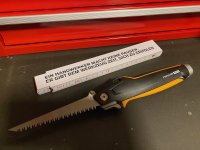 IMG_5767.jpeg234.7 KB · Views: 1,371
IMG_5767.jpeg234.7 KB · Views: 1,371 -
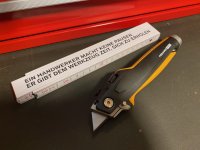 IMG_5766.jpeg219.6 KB · Views: 1,368
IMG_5766.jpeg219.6 KB · Views: 1,368

